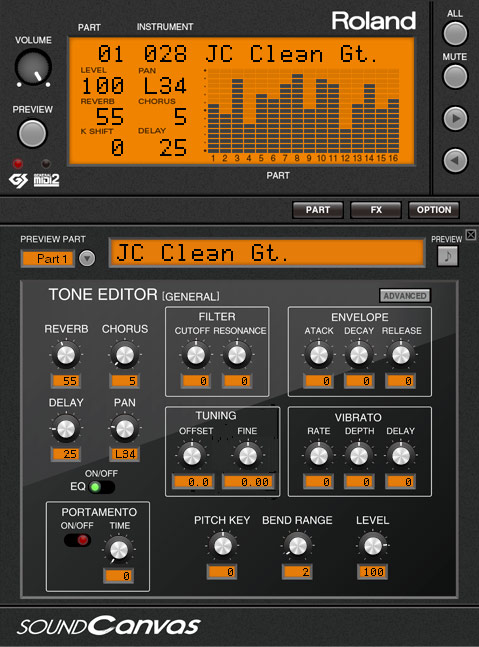And the Microsoft GS Wavetable Synthesizer is designed to provide MIDI playback with as little memory usage as possible, so it isn't really comparable to the Roland SC-55. It's also worth mentioning that neither the Microsoft GS Wavetable Synthesizer, nor the Roland SC-55 use soundfonts. Patch93's SC-55 v2.2 soundfont is similar to real SC-55, but is poorly balanced: drums are really too loud and some more instruments sounds wrong. Now my last hope for Heretic, Hexen, Strife is Merlin Vienna soundfont (downloaded in Tim Brechbill's Timidity page).
Keyboards and Soundfonts.
Anyone who is interested in music, at a time of his life, definitely bought a keyboard.
My first keyboard was Roland D20.

Then there were many keyboard and sound modules.
For example:
Roland D20
Good old keyboard. Has 16 Track mini Sequencer.
LA sounds. Disket Drive (3.5)
Roland SC-55
Famous module! Mother of all GS instruments.
Has good sounds.
Yamaha PS-55
Very old Keyboard with auto-accompaniment.
Limited sounds and acc. rhythms.
Casio AP33
Very good Piano
E-MU Proteus 1
Old module. Has unique sounds.
Roland U110
Very good sounds. Separate channel outputs. Studio Quality.
Kawai K11
Performance keyboard. 2 x Midi module (A and B).
The volume slider deteriorates after a period of use.
Korg M1
Both good and bad features. but Famous. Aftertouch feature is very good.

Roland Sc55 Download

| Developer | Roland Corporation |
|---|---|
| Type | General MIDI |
| Release date | 1991 |
| Platform | IBM PC, PC-88, PC-98, Sharp X68000 |
| Predecessor | Roland MT-32 |
| Successor | Roland SC-88 |
| Related articles | Roland SC-8850 |
The Roland SC-55 (Sound Canvas) is a GSMIDIsound module released in 1991 by Roland. The SC-55 was the first sound module to incorporate the new General MIDI standard. It was the first in the Roland Sound Canvas series.
The SC-55 used both PCM and a cut-down version of the LA synthesis engine, to support 24-voice polyphony with 16-part multitimbrality. It came preloaded with the Roland MT-32's variation bank, but lacked the MT-32's re-programmability. Aimed at PC music enthusiasts, the SC-55 featured 317 instrument patches, including the GS drum kits and additional controllers. The selection of effects includes reverb and chorus.
Alongside the SC-55, Roland released the SB-55 (Sound Brush), an inexpensive MIDI sequencer module the same size as the Sound Canvas. Both the Sound Canvas and Sound Brush could be rackmounted alongside each other.
Other models with comparable tone generators include Roland CM-300, Roland CM-500 and Roland SC-155 sound modules. CM-300 and CM-500 models lack the LCD screen and extended controls of SC-55. Both models have external appearance nearly identical to Roland's earlier CM-32/64-series modules. SC-155 adds additional slider controls for master and channel level and panning. Additionally, CM-500 includes fully SysEx compatible LA tone generator similar to CM-32Ls.
The SC-55mkII[edit]
A minor upgrade to the original SC-55, the Roland SC-55mkII has increased polyphony (28 voices), more patches, raising the total number to 354 instruments and extended, and improved audio-circuitry in the form of 18-bit audio (versus 16-bit in the original SC 55.)
The SC-55mkII added a serial port as an alternative interface to the MPU-401.

Roland SCC-1[edit]
Roland also released the Roland SCC-1, an 8-bit ISA half-size card incarnation of the SC-55 sound module. The sound source is controlled by an on-board MIDI Processing Unit, a variant of the MPU-401 unit. An updated version featuring the SC-55mkII sound set was also released, known as SCC-1A. When bundled with the Band-in-a-Box and BalladeGS software, it's called SCC-1B.
Roland Sc-55 Soundfont
Roland later replaced the SCC-1 with a combination of their MPU-401AT MIDI interface card and SCB-55 Wave Blaster-compatible daughterboard. Roland referred to this combination as the SCM-15AT. The SCC-1 was also sold as the GPPC-N for the NEC PC-98.
CM-32P and MT-32 Emulation[edit]
Since the SC-55 has no programmable memory, CM-32P and MT-32 emulation is done by providing the same sound arrangement as the preset sounds of actual devices. These variation banks are enabled by playing back special SysEx containing MIDI files, for example GS32.MID (included in the SCC-1 Utility Software), prior to loading a software title. These specially arranged tone tables contain the relevant GS sound mapped at either CM-32P or MT-32 program number. Pitch bend range is changed to 12 semitone from GS default 2 semitones. Master tuning and modulation depth are not altered by the emulation. Pan directions are reversed from actual CM-32P or MT-32 devices. CM-32P or MT-32 specific MIDISysEx messages are also ignored by the SC-55.
MT-32 Emulation Samples[edit]
The Roland SC-55's CM-32P and MT-32 emulation is based on using preset sounds of the actual devices without utilizing programmable memory or actual device synthesis techniques. This results in poor emulation for software titles relying on custom programmable MT-32 sounds as demonstrated by the introduction of the Sierra On-Line game Space Quest III: The Pirates of Pestulon.
Software titles supporting the Roland MT-32 but not utilizing its memory are emulated with better results as demonstrated by the introduction song from Origin Systems' Ultima VI: The False Prophet.
Notable Users[edit]
Roland Sc 55 Soundfont Download
- Liz Kitchen (Tweenies, Playdays, Tikkabilla, The Shiny Show)
- Francis Haines (The Story Makers, Mr Men, Timbuctoo, The Shiny Show, Tikkabilla, Busy Buses)
- Robert Hartley (Brum, Teletubbies, Rosie and Jim, ChuckleVision)
- Kim Goody & Alan Coates (Fifi and the Flowertots, Tiny Planets, Mike & Angelo, Roary the Racing Car)
- KICK Productions (Sitting Ducks, Fimbles, Rubbadubbers, The Beano Allstars
- Bob Singleton (Barney & Friends)
See also[edit]
Further reading[edit]
- 'Roland Sound Canvas SC-55 MK2'. The Amiga Buyer's Guide '94. No. 1. Winter 1994. p. 172.